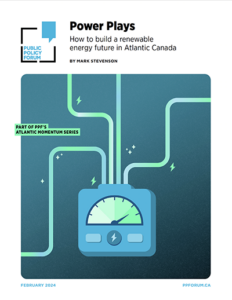
Power Plays
How to build a renewable energy future in Atlantic Canada
With three facilities in Nova Scotia, Michelin Canada is one of the province’s biggest private-sector employers and its single biggest exporter. So, when it announces a $300-million investment to expand and upgrade its facilities, that’s very good news for the province, and not just because it will create jobs.
The investment is driven in part by Michelin’s strategy to reduce greenhouse gas emissions 50 percent by 2030 on the way to net zero. The company will be installing technology to improve the fuel efficiency of commercial truck tires, expanding production of tires for electric vehicles (which need to handle more weight and torque), and improving the energy efficiency of its factories. It’s already switched from bunker sea oil to natural gas and it’s investigating biomass and hydrogen as well. Access to clean, renewable energy is critical to the company’s future, says Andrew Mutch, president of Michelin North America (Canada) Inc.
Mutch runs through a list of recent environmental calamities to drive home the need to move fast. “Just here in Nova Scotia we had [hurricane] Fiona, then we had wildfires, then we got floods, and more hurricanes coming. You can tangibly see this world needs a rapid response.”
It’s a business imperative as well. His customers, whether big car makers or retailers, are demanding Michelin help them meet their own environmental goals. Shareholders want action, too. The fact that Nova Scotia has committed to an aggressive plan to get to net zero — that the goals of both the company and the province are aligned — is important. “We see ourselves as leaders in this domain,” he says. “We recognize we need to move fast. And we are encouraging the ecosystem around us to move as fast as possible as well.”
Atlantic Canada will need to provide industry with reliable, renewable non-emitting energy if it hopes to stay competitive and draw economic development to the region. All four provinces have committed to achieving net zero emissions by 2050, in line with the federal government’s national decarbonization goal. (Prince Edward Island aims[1] to be the first province to get there, in fact, with a target date of 2040.)
The region has already made significant progress. Since 2005, New Brunswick and Nova Scotia have led all provinces in reducing emissions, cutting them 43 percent and 36 percent respectively.[2] Prince Edward Island and Newfoundland and Labrador were fourth and fifth best. Atlantic Canada has taken important steps to green its electrical grid. With the Muskrat Falls hydro project now online, Newfoundland and Labrador’s grid is now 98 percent renewable. P.E.I.’s generation is almost completely from renewables, though it imports more than 70 percent of its electricity from New Brunswick. Overall, the Clean Power Roadmap for Atlantic Canada noted the region, as of 2022, had lowered carbon emissions from electricity production by 27 percent below 2005 levels.[3]
There is still a lot to be done. The Public Policy Forum’s Atlantic Canada Momentum Index shows that growth in the production of non-emitting energy was essentially flat from 2015 to 2020,[4] though these numbers will have improved since Muskrat Falls has come online, and Nova Scotia and New Brunswick have added wind generation. The growth rate is going to have to pick up substantially, however, because the energy profile of the region’s two biggest provinces must change fast. Both Nova Scotia and New Brunswick still burn coal — 45.6 percent of electricity comes from coal in Nova Scotia and 12.2 percent in New Brunswick — and federal regulations demand it be phased out by 2030. And electrical grids will need to be completely non-emitting by 2035.[5]
New capacity needs to be built to replace those phased-out fossil fuels. Add to that the fact that Atlantic Canada, like the whole country, will see a huge rise in demand as electricity becomes the dominant power source for the net zero world. The Canada Energy Regulator projects the region’s power generation needs will increase by 60 percent to 100 terawatt hours (TWh) by 2050 (from 62 TWh in 2021).[6]
Transforming the energy that drives the country to non-emitting electricity will be, as the Public Policy Forum put it in a recent report, the “project of the century.”[7] Adds the Atlantic Canada Roadmap, with some understatement: “Bold action will be required to significantly invest in the regional power system over a short time horizon.”
Just what the final energy mix will be for individual provinces and how it will be achieved are the big, important questions. All four Atlantic provinces have produced renewable energy plans with varying degrees of specificity, all of which have been criticized for lacking detail and firm commitments. Nova Scotia plans[8] for 80 percent of its electricity to come from renewables by 2030, with fully half from onshore wind, which is up from 20 percent today.[9] It has also set a target to license five gigawatts (GW) of offshore capacity by 2030.[10] (In some of the scenarios it presents, Nova Scotia Power, the provincial utility, foresees adding small modular nuclear reactors, or SMRs, to the mix late in the transition process, which would mean ending a current legislated ban on building nuclear power in the province.)[11]
New Brunswick’s plan also offers multiple scenarios,[12] but includes two SMRs, at least 200 megawatts (MW) of new wind power, a multi-billion overhaul of the Mactaquac hydro dam and the possible conversion of its Belledune coal-fired plant to biomass.[13] P.E.I’s clean energy plan[14] is largely a discussion paper that promised a strategy this fall[15] and Newfoundland and Labrador’s, which goes out to just 2026, notes that its renewable energy profile is already so robust that a lot of the work to be done is in finding new opportunities.[16]
Transmission capabilities will also need to be bolstered and new flexibility introduced to accommodate intermittent power sources like solar and wind. The Atlantic Loop, a proposal to add transmission lines between Quebec and New Brunswick, and upgraded capacity between Nova Scotia and New Brunswick, has been thought of for years as a critical part of the clean energy transition. Adding bi-directional transmission capabilities could also allow for Atlantic Canada to export surplus energy, particularly from offshore wind.
The sticking point has been cost and, despite a reported $4.5-billion loan offer from the federal government, Nova Scotia and New Brunswick haven’t signed on. Instead, they’ve opted for a “modified Atlantic Loop” improving one transmission line across their shared border.
The rush is on to build just about everything else, however. In February, New Brunswick Power put out a request for proposals for 220 MW of renewable energy (almost all of it wind) and 50 MW of energy storage. Last summer, Nova Scotia picked five wind projects to proceed, all with Indigenous majority ownership, which will generate 1,373 gigawatt hours of power per year, about 12 percent of the province’s needs.[17] Newfoundland and Labrador lifted a moratorium on new wind developments in 2022 and last August picked four companies to proceed with plans to build wind farms to supply green hydrogen production facilities.[18] P.E.I. is building a new transmission line to the western end of the province to serve new wind power projects, and a 21-MW solar project in Summerside — the largest solar project in the region — went online last year.
Offshore wind power could be the true game changer for Atlantic Canada, though so far the region’s ambitions for it have not caught up with its potential. It’s more expensive than onshore wind at the moment, but it has a number of inherent advantages: It’s easier for the electrical grid to accommodate; offshore winds are more consistent and blow strongest in winter when demand is greater; and it faces less NIMBY opposition from those who think turbines unsightly or, somehow, dangerous.
A recent Public Policy Forum report noted the scale of the opportunity.[19] The Sable Island Bank, for instance, an undersea plateau off the coast of Nova Scotia, could accommodate at least 1,000 offshore turbines, each with 15-MW capacity — enough to supply 6.5 million average Canadian homes or almost twice the total electricity currently consumed in Atlantic Canada annually. And Sable Island Bank is just one potential site. “Offshore wind could be for Atlantic Canada what oil was to Texas or hydro power to Quebec,” says the report. “We are talking here not of something incremental, but monumental.”
Hydrogen could be another key to a net zero future for Atlantic Canada. It’s of particular interest to heavy industry and to the freight transportation sector. But is largely seen as a possible export to the EU. Producing “green” hydrogen via electrolysis of water requires large quantities of electricity for which wind farms near deep water ports and offshore wind installations would seem well suited. It’s expensive to produce however, about five times more expensive than hydrogen produced with natural gas.
The cost of such an ambitious transformation, and who should pay it, is naturally of great concern in Atlantic Canada. The region already has some of the highest electricity rates in the country[20] — Charlottetown and Halifax are two of the three priciest urban markets;[21] electricity rates rose more than 70 percent from 2004 to 2014 as the region began to move off fossil fuels; cost overruns on the Muskrat Falls project drove up rates in Newfoundland. When Canadian Manufacturers & Exporters asked its members in 2019 what government actions would be most effective in supporting businesses in the region, lowering energy costs was by far the highest-scoring option.[22]
The good news is that as supply chains are built, economies of scale are developed and innovation happens, the cost of renewable power will come down. The Canada Energy Regulator projects some rather spectacular declines in capital costs, particularly for solar (44 percent by 2030, 60 percent by 2050) and green hydrogen (74 percent and 82 percent). An analysis of cost trends by the U.S. National Renewable Energy Laboratory projects a decrease in costs for offshore wind of more than 25 percent by 2030, compared to 2021, and almost 45 percent by 2050. And, of course, as carbon taxes rise, the cost of sticking with fossil fuels will become unworkable.
One question for policy-makers is how best to encourage the transition. The federal government has a raft of fiscal and financial incentives, including a Clean Electricity Investment Tax Credit and a Clean Hydrogen Investment Tax Credit, in addition to making $20 billion available through the Canada Infrastructure Bank for clean power and green infrastructure.
The Atlantic Economic Council recommends more provincial government programs such as New Brunswick’s Corporate Cleantech Innovation Fund to help build the supply chains needed.[23] Atlantic Canada has much lower levels of business investment in research and development overall than Canada as a whole, as the Momentum Index has noted, and it needs to improve especially in clean technology.
There are other ways government can help quicken the pace. The federal government has promised to improve the efficiency and speed of impact assessments and permitting processes for major projects. Provincial governments and utilities could bring some certainty to transition by nailing down specific targets and timelines on their net zero plans. Provinces should co-operate on interconnected grids to build in flexibility.
Regulators and policy-makers will find the business community receptive. Like Michelin, more and more companies are adopting aggressive climate change strategies. ESG (environmental, social, governance) standards and disclosure are becoming more common. This may be in part to stay ahead of regulators: The federal government is working toward imposing mandatory climate reporting for federally regulated financial institutions and pension plans,[24] and market regulators such as the Office of the Superintendent of Financial Institutions and the Canadian Securities Administrators have rules in the works as well.[25] Commitments to using clean, renewable energy and to pushing those demands down the supply chain are often a key part of sustainability reports that big companies now showcase.[26]
Clean energy may eventually become the cost of market access. As countries lower their own emissions and companies incur the cost, there’s more and more discussion of carbon tariffs — effectively a tax or penalty on imports based on their “carbon content.” These would encourage decarbonization and give countries that have made progress a competitive advantage.
But along with the costs and pressures to decarbonize, there is also a massive opportunity for economic development. Building renewable energy infrastructure will create jobs and technological expertise, establish supply chains in the growing clean energy sector and give Atlantic Canada a chance to become a leader in a new economy. As the Atlantic Economic Council pointed out in a report in October 2022: “The region’s economic size means we are largely technology takers, but there are some areas where we could influence the development of net zero technology on a larger scale.”[27]
Small modular reactors are one example. New Brunswick Power has partnered with two private-sector corporations to develop a research centre for SMR technology, with plans to build two demonstration units at the Point Lepreau Nuclear Generating Station site.[28] It sees the project creating 11,000 jobs over 15 years and adding $1 billion to the province’s GDP.
Offshore wind is another massive opportunity. Consider that the installation of 15 GW of offshore wind generation would create an average of approximately 30,000 direct jobs annually during several years of construction and installation, and about 1,200 permanent jobs for ongoing operation and maintenance.[29]
Establishing Atlantic Canada as a source of clean, renewable energy could boost employment, income and exports, and be a means to expand the economic boom captured in the Atlantic Momentum Index. Combining clean energy with ready access to deep-water ports could make the region a location of choice.
Business leaders working in the global market, like Andrew Mutch, believe in that future. “The opportunity for Nova Scotia and the Atlantic provinces is clear. The need for the transition is clear but the time is short. It’s a huge transition we need to go through. There is a lot of investment that has to be made, and it has to be made very effectively and very efficiently. It takes a lot of people aligned to a common vision rolling up their sleeves and saying, ‘Let’s get it done.’”
- Path to Net Zero. https://www.princeedwardisland.ca/en/information/environment-energy-and-climate-action/path-to-net-zero. Government of Prince Edward Island. ↑
- United Nations. (Apr. 17, 2023). Canada. 2023 National Inventory Report (NIR). https://unfccc.int/documents/627833. ↑
- Natural Resources Canada. (n.d.). Clean Power Roadmap For Atlantic Canada. https://natural-resources.canada.ca/sites/nrcan/files/energy/images/publications/2022/A%20CLEAN%20POWER%20ROADMAP%20FOR%20ATLANTIC%20CANADA-ACC.pdf. ↑
- Sharpe, A. (Mar. 22, 2023). The Atlantic Canada Momentum Index. https://ppforum.ca/publications/the-atlantic-canada-momentum-index/. Public Policy Forum. ↑
- Ibid. ↑
- Canada Energy Regulator. (n.d.). Canada’s Energy Future 2023: Energy Supply and Demand Projections to 2050. https://www.cer-rec.gc.ca/en/data-analysis/canada-energy-future/2023/. Government of Canada. ↑
- Annesley, J., Campbell, D., Golshan, A., and Greenspon, E. (July 19, 2023). Project of the Century: A Blueprint for Growing Canada’s Clean Electricity Supply – and Fast. https://ppforum.ca/publications/net-zero-electricity-canada-capacity/. PPF. ↑
- Withers, P. (Oct. 11, 2023). N.S. abandons Atlantic Loop, will increase wind and solar energy projects for green electricity. https://www.cbc.ca/news/canada/nova-scotia/clean-power-plan-abandons-atlantic-loop-1.6992765. CBC. ↑
- Armstrong, L., The Canadian Press. (Oct. 11, 2023). Atlantic Loop no longer part of Nova Scotia plan to hit 2030 renewable energy targets. https://atlantic.ctvnews.ca/atlantic-loop-no-longer-part-of-nova-scotia-plan-to-hit-2030-renewable-energy-targets-1.6597337. CTV News. ↑
- Natural Resources and Renewables. (May 2023). Nova Scotia Offshore Wind Roadmap. https://novascotia.ca/offshore-wind/docs/offshore-wind-roadmap.pdf. Government of Nova Scotia. ↑
- Nova Scotia Power. (Aug. 8, 2023). Powering a Green Nova Scotia, Together. https://irp.nspower.ca/files/key-documents/annual-evergreen-materials/Evergreen-IRP-Update-to-IRP-Action-Plan-and-Roadmap-2023.pdf. ↑
- New Brunswick Power. (n.d.). 2023 Integrated Resource Plan (IRP): Pathways to a Net-Zero Electricity System. https://www.nbpower.com/en/about-us/our-energy/integrated-resource-plan/. ↑
- Chilibeck, J. (Aug. 8, 2023). Questions remain over multibillion-dollar plan to fix New Brunswick’s biggest hydroelectric dam. https://www.saltwire.com/atlantic-canada/business/questions-remain-over-multibillion-dollar-plan-to-fix-new-brunswicks-biggest-hydroelectric-dam-100881098/#:~:text=Still%20missing%20is%20a%20reliable,%242%20billion%20and%20%243.6%20billion. Saltwire. ↑
- Government of Prince Edward Island. (n.d.). Provincial Energy Strategy 2016/17. https://www.princeedwardisland.ca/en/information/environment-energy-and-climate-action/energy-strategy. ↑
- Government of Prince Edward Island. (April 20, 2023). PEI Energy Blueprint Discussion Paper. https://www.princeedwardisland.ca/sites/default/files/publications/blueprint_discussion_paper_2023.pdf. ↑
- Government of Newfoundland and Labrador. (n.d.) Maximizing Our Renewable Future. https://www.gov.nl.ca/iet/files/Renewable-Energy-Plan-Final.pdf. ↑
- Smith, S. (Aug. 17, 2022). N.S. selects five wind projects to produce electricity from renewable sources. https://www.cbc.ca/news/canada/nova-scotia/n-s-selects-five-projects-largest-ever-wind-procurement-1.6553677. CBC. ↑
- Nickel, R. (Aug. 30, 2023). Canadian province Newfoundland picks 4 wind farm projects to power hydrogen plants. https://www.reuters.com/business/energy/canadian-province-newfoundland-picks-4-wind-farm-projects-power-hydrogen-plants-2023-08-30/. Reuters. ↑
- Nicholson, P. (October 2023). Catching the Wind: How Atlantic Canada Can Become an Energy Superpower. https://ppforum.ca/wp-content/uploads/2023/10/CatchingTheWind-AtlanticCanadaEnergySuperpower-PPF-Oct2023-EN.pdf. PPF. ↑
- Natural Resources Canada. (n.d.). Clean Power Roadmap for Atlantic Canada. https://natural-resources.canada.ca/energy/electricity-infrastructure/electricity-infrastructure-publications/clean-power-roadmap-for-atlantic-canada/24190. Government of Canada. ↑
- Atlantic Economic Council. (May 25, 2023). Net-Zero – Why is energy so important our net-zero transition? https://atlanticeconomiccouncil.ca/page/NetZeroWhyIsEnergyImportantMay2023. ↑
- Canadian Manufacturers & Exporters. (July 24, 2019). Unlocking Atlantic Canada’s Growth Potential. https://cme-mec.ca/blog/cme-releases-new-study-on-innovation-in-atlantic-canadas-manufacturing-sector/. ↑
- New Brunswick Innovation Foundation. (n.d.). Corporate Cleantech Innovation Fund. https://nbif.ca/corporate-cleantech-innovation-fund/. ↑
- Department of Finance Canada. (Sept. 16, 2021). Summary Report of Private Sector Perspectives on Enhanced Climate Related Financial Disclosures. https://www.canada.ca/en/department-finance/programs/financial-sector-policy/sustainable-finance/sustainable-finance-action-council/summary-report-private-sector-perspectives.html. Government of Canada. ↑
- Jones, J. (Aug. 25, 2023). Expert panel tells Ottawa to move faster on corporate disclosure of climate risks. https://www.theglobeandmail.com/business/article-expert-panel-tells-ottawa-to-move-faster-on-corporate-disclosure-of/. Globe and Mail. ↑
- McCain Foods Limited. (January 2023). McCain Sustainability Report 2022. https://www.mccain.com/media/4060/mccain-foods-sustainability-report-2022.pdf. ↑
- Atlantic Economic Council. (October 2022). Net-Zero – Overview of Atlantic Canada. https://atlanticeconomiccouncil.ca/page/NetZeroReport1Oct22. ↑
- New Brunswick Power. (n.d.). Small modular reactors in New Brunswick. https://smrnb.ca/. ↑
- Stefek, J., et al. (October 2022). U.S. Offshore Wind Workforce Assessment. https://www.nrel.gov/docs/fy23osti/81798.pdf. NREL. ↑
Thank you for your support
Atlantic Canada Opportunities Agency (ACOA), Government of Canada, NATIONAL Public Relations, McKenna Family Fund (Arthur, Sandra and Sarah Irving, Joyce Family Foundation, Hon. Margaret McCain, Hon. Frank McKenna, Oceans Capital Investment Ltd., Gerry Pond. Joseph Shannon, McInnes Cooper, TD Bank Group)








